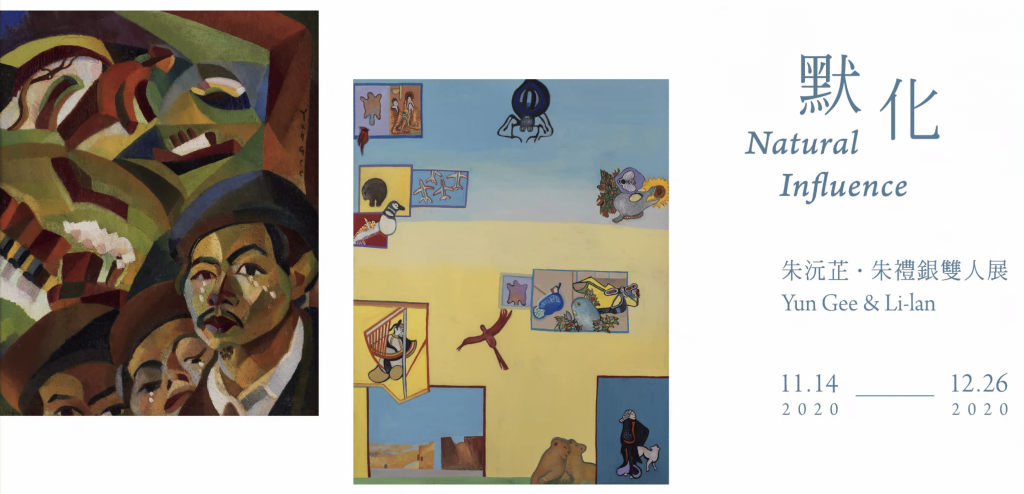
Yun Gee and Li-lan: Natural Influence
Exhibition Dates| 11.14.2020–12.26.2020
Venue| Tina Keng Gallery (3F, No. 15, Ln. 548, Ruiguang Rd., Neihu Dist., Taipei, Taiwan 114)
Reception| 11.14.2020 (Sat.) 4:30 p.m.
The Tina Keng Gallery is pleased to present Yun Gee & Li-lan: Natural Influence, comprising the works of Chinese-born American artist Yun Gee and his daughter Li-lan. The works on view usher the viewer into the life of Yun Gee, a leading figure in Greater Chinese modernism, and of Li-lan, who with an immanent artistic passion, has cultivated a different path in her own painting practice. Both unconfined by their geographical and cultural contexts, they develop distinctive aesthetics that allow them to initiate a dialogue between cultures that expands beyond the personal experiences that define them.
Immigrating to San Francisco at the age of 15 in 1921, Yun Gee developed a seminal style that grounds vibrant, bold color blocks in cool, rigorous delineations. A style that found its roots in Cubism and flourished under the influence of Synchromism, championed by his mentors at the California School of Fine Arts. Being in a foreign land, suppressed by racial bias, he became wistfully nostalgic for his mother and home country. This melancholy yearning nurtured his art as well as his conviction that he deserved recognition for his cultural identity. In 1927, Yun Gee was introduced to Prince and Princess Achille Murat, who were impressed by his work and encouraged him to move to Paris. And he did. Yun Gee’s later move to Paris exposed him to significant European influences. Earnestly embraced by the Parisian art circle, his work instantiated the fusion of East and West in an ingenious synergy of Chinese cultural symbols and Western painting styles.
Social upheaval in the 1930s sent Yun Gee back and forth between Paris and New York. But in 1932 he was invited to be in the group exhibition Murals by American Painters and Photographers at the Museum of Modern Art in New York. For this exhibition he created the work Wheels: Industrial New York rendered in his singular “Diamondism.” Profoundly influenced by Synchromism, Diamondism focused on a rhythmic organization of edges and facets, as well as hot and cold color contrasts. It embodied Yun Gee’s attempt to explain the intellectual, physical, and psychological coordinates of artistic creation after much contemplation about China’s tradition, philosophy, and culture. This fortified Yun Gee’s status as one of the pioneering Chinese modern artists in history, as well as marking a milestone for Greater Chinese artists.
Born in New York, Li-lan is as much an independent spirit as her father. She does not want to only be known as the daughter of Yun Gee, who also happened to be an artist. After graduating from the city’s High School for the Performing Arts, she became not an actor, musician or dancer, but a painter. For her, the solitude of the studio was more congenial than collaborating as an actor or a dancer on the stage. Throughout her life, she has been animated by a quiet rebelliousness that shows, obliquely, in the independent characteristic of her art at every stage of her career.
Nurtured in a transcultural heritage, Li-lan has chosen a divergent path to express her life experiences. A meticulous composition pregnant with potent cultural symbols transports the viewer to Li-lan’s fanciful world that pulsates with her musings. Li-lan first worked in Abstract Expressionism in the 1960s, followed by her work with white paper, legal pads, and office and business ephemera, such as notebooks and invoices, in the 1970s. In the 1980s, the artist collected stamps, envelopes, and postcards — ephemera that embody her communication with friends and family across the sea. Her depictions of human figures, amphibians, and insects act as reminders of fleeting memories and bygone times, abounded in earthly transience. Her transcultural background inspires her use of multifarious cultural references, in a way as a response to her own identity.
“Li-lan belongs in the same way as I do to that increasing number of not exactly belonging people,” artist Isamu Noguchi once wrote. Even though he was speaking of his long-time friend, Li-lan, the same sentiment could have been written about Yun Gee. It is in this fashion that they share the most natural influence. Yun Gee and Li-lan are two unique artists that forged lives and careers in a world where they didn’t quite belong. Their respective journeys seem to have transcended the visual experiences of their works, rendered on canvas in a pictorial language both visible and intangible that bears witness to their familial ties and artistic bond.